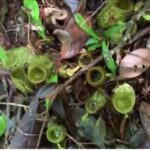As an Amazon Associate, this site earns commissions from qualifying purchases. For more details, click here.
Nepenthes mirabilis is one of the most widely grown pitcher plants in the world. It is easy to cultivate which makes it suitable for those who have no experience with carnivorous plants. In this guide you will learn how to grow and keep a n. mirabilis alive for many years.
Nepenthes mirabilis should be in full, indirect sunlight at 50-85 F (10-30 C) and 80-100% humidity. Use low nutrition media for the soil like peat, sphagnum and perlite. This plant does not go dormant and blooms the entire year.
Nepenthes Mirabilis Care Sheet
| Soil | 1:1 peat and perlite, keep soil damp |
| Water | Purified, distilled, rainwater |
| Light | 6-8 hours full indirect sunlight, indoor lights are fine |
| Food | Insects, dried mealworms, fish food |
| Temperature | 50-85 F (10-30 C) |
| Humidity | 80-100% |
| Dormancy | Not required |
| Propagation | Leaf pulling |
Soil
Peat moss and perlite are widely used with n. mirabilis, Other options are long sphagnum fiber, silica sand, fir bark and vermiculite. The media should be low in nutrition, porous and with good drainage.
The most common mix ratio is 1:1, but 2:1 and 3:1 are not unheard of. If you are not sure what to do, there are premixed soil mixes available. If you a quick, easy solution, we suggest the soil mix by Perfect Plants because it is well suited for nepenthes.. You can also order your nepenthes along with a pot.
If mixing your own soil, ensure there is sufficient drainage so air can flow into the roots. With enough experience you will learn what media works well with your n. mirabilis. For now just stick with premixed soil so you can see how well the plant responds.
Try to keep the soil free from nutrients such as fertilizers or food. If you are feeding nepenthes, make sure nothing spills into the soil. Over time these nutrients will add up and damage the plant, causing it to stink and even perish.
Pot Container
For these plants, a 3-5 inch container is the right size. Plastic containers are fine, but do not use clay pots because they tend to accumulate minerals.
You can buy nepenthes with soil and pot or even baskets if you prefer hanging pitcher plants, The benefit of an all in one solution – plant, soil and pot – is that everything is ready. On the other hand, preparing the materials separately gives you more control. For beginners, the all in one approach is better.
Nepenthes are usually repotted every two years. You should do it right away though if your pitcher plant grows larger than expected. Its roots will need more room to expand so a 3 inch container is not enough. Repot if the soil is contaminated or dries too quickly.
Water generously after your nepenthes has been repotted. Some nepenthes undergo a shock during this process and watering helps the plant settle down.
Water
Nepenthes mirabilis should always be in damp media. Water from the top until the soil is moist. Purified, distilled and spring water are ideal. You may also use tap water if the chlorine level is low.
Do not sit nepenthes mirabilis in water. While the plant prefers moist soil, too much water will damage its roots. This could even be fatal to the plant.
If the soil dries too fast, repot and try other potting media. You can also increase humidity and water more often. But do not use the tray method because n. mirabilis is vulnerable to rot. Instead during summer, spray freely and generously to moisten the soil.
Aside from watering, there are a couple of other things you can do to keep the soil damp. One is to avoid direct sunlight so it does not dry out. The other is to move the plant indoors and install a humidifier to boost humidity.
Light
These plants grow in full, indirect sunlight. You may also use artificial lights. If you can keep the plant under bright light but partially shaded, that is ideal.
Outdoors. Please keep in mind that n. mirabilis blooms all year and does not go dormant. Move the plant to a warm location if you have harsh winters. During spring and summer, look for a sunny spot in your garden.
Leave the plant there to absorb the sun. If you live in a mild temperate climate (rarely goes over 85 F / 30 C), your n. mirabilis will be fine. You should partially cover it (no more than 50%) if it gets too hot.
An obvious sign of overheating and scorching is discoloration. Nepenthes mirabilis colors may become more intense under sunlight. But too much and the plant weakens .The first indication is discoloration and the second is the traps become dry, killing the good bacteria and animals inside it.
Indoors. Same as outdoors, expose the plant to bright light but indirectly. A windowsill is a great option. Your nepenthes will get plenty of sun but its location prevents direct contact.
Artificial lights. Nepenthes grow nicely under plant lights. Look for those made specifically for plants such as the Watotgafer Grow Lights and follow instructions for their use. You will need these lights because n. mirabilis grows the whole year.
Temperature
The temperature range is 50-85 F (10-30 C) Ideally nepenthes mirabilis should be in 50 F at night and no more than 85 F during the day.
As usual there are exceptions to the rule. Some nepenthes do well up to 95 F and others are fine at 45 F. A lot of this has to do with their health and environment.
A healthy, well fed nepenthes can handle more heat and cold than a sick one. All of these variables – temperature, light, water, humidity, nutrition etc. – affect each other. If your pitcher plants grow in a healthy location, they will be more than capable of dealing with heat and coldness.
The opposite is also true. A nepenthes that suffers from lack of water, nutrition and the wrong soil will not last long. Even if you keep the plant in the right temperature range, it will not be enough. So all these factors have to be considered together.
Humidity
Nepenthes mirabilis prefers 80-100% humidity. The higher the rate, the more liquids the plant can produce in its pitchers.
While pitcher plants create glucose through photosynthesis, nepenthes still needs the nutrients that insects provide. Without enough nutrients the plant can die. Here is a guide on knowing the signs of a dying pitcher plant and how to save it. Plenty of humidity will help.
Some pitcher plants survive in low humidity. It is possible that n. mirabilis can too. But low humidity will force the plant to stop creating traps. The existing pitchers will dry out and not be replaced. Without any pitchers, your nepenthes will no longer be able to catch and eat prey.
You can grow n. mirabilis in a terrarium like the Ferrisland Glass House or a greenhouse to control humidity. If you do that, make certain there is enough ventilation. Do not allow the air to stagnate or the greenhouse / terrarium to overheat.
Nutrition and Feeding
Outdoor pitcher plants do not have to be fed as there is plenty of prey available. Since nepenthes mirabilis is usually grown indoors, feeding may be necessary.
If your nepenthes is in a location where it cannot catch prey, drop a bug or two in its pitcher every week. The larger the insect, the fewer you should give.
Catching live insects is hard, but fortunately you can give it fish pellets or freeze dried mealworms. Just place a few in a pitcher and that should be enough. Some feed their pitcher plants highly diluted fertilizer, but do that only if you are an expert.
Dormancy
Nepenthes mirabilis does not need dormancy. The plant blooms and grows the entire year.
If you live in a tropical or fair weather area, it is safe to leave the plant outdoors. If there is freezing winter, grow nepenthes indoors. Use indoor plant lights during winter and make sure it is kept in mild temperature and high humidity.
Even though nepenthes mirabilis does not go dormant, its growth usually slows down in winter. As spring arrives the plant slowly returns to its normal pace and produces new flowers and traps. This is also the best time to propagate pitcher plants. You may also repot around this time.

My fascination with carnivorous plants began many, many years ago with Venus Fly Traps. Now I am more than happy to impart what I know with other enthusiasts and those who are curious about meat eating plants.



